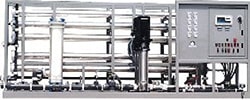 The EPA and other world health organizations have sounded the alarm on the dangers and health impacts of being exposed to per- and polyfluoroalkyl substances (PFASs & PFOAs) also known as the forever chemicals.
The EPA and other world health organizations have sounded the alarm on the dangers and health impacts of being exposed to per- and polyfluoroalkyl substances (PFASs & PFOAs) also known as the forever chemicals.
In response, federal and state regulators are adopting new water quality guidelines and laws to address these contaminants in our drinking water systems and groundwater pollution. It's a pervasive issue, as PFASs can be found in various types and over 4,700 different variations, each with at least three polyfluorinated carbon atoms.
With more than 10,000 types of PFASs introduced into products, it's no wonder that the quality of drinking water in the USA and other countries has been compromised. But what exactly are PFASs? These are fluorinated substances that contain at least one fully fluorinated methyl or methylene carbon atom. While they do not contain atoms like hydrogen, chlorine, bromine, or iodine, any chemical with a perfluorinated (CF3) or perfluorinated (CF2) component falls under the PFAS category. However, there are a few exceptions.
PFASs can be further classified into subgroups such as surfactants, perfluorosulfonic acids, perfluorooctane sulfonic acids, perfluorocarboxylic acids, and perfluorooctanoic acids (commonly referred to as PFOSs and PFOAs). These persistent organic pollutants, also known as "forever chemicals," pose a significant challenge due to their resistance to environmental degradation. As a result, they are found in humans, animals, and water supplies across the USA.
Recognizing the gravity of the situation, the ban on PFOS, PFOA, and other PFASs was initiated in 2021 with The Safe Drinking Water Act. Leading the charge, Maine became the first state in the US to implement the ban, with plans to discontinue their use in all products by 2030, unless there are no viable alternatives available. This regulatory action aims to mitigate the presence of forever chemicals and protect the population from their adverse effects.
When it comes to designing and selecting materials for water treatment equipment manufacturing, compliance with NSF/ANSI 61 regulations is crucial. Understanding the regulatory and construction standards required is essential to ensure the creation of safe drinking water systems. Reverse osmosis, a membrane technology, is commonly used for water filtration, alongside processes like decarbonation of carbon dioxide, degasification of hydrogen sulfide, and water filtration, which help eliminate micron particles from both potable and non-potable water.
Engineers and manufacturers in the water treatment industry often encounter NSF/ANSI 61 requirements, established by an international nonprofit organization called NSF. This organization is dedicated to public health and safety in relation to potable water systems and their components. NSF/ANSI 61 provides minimum requirements to control potential adverse human health effects resulting from contact with drinking water products and their components.
DeLoach Industries Inc., a reputable manufacturer of water treatment equipment, strictly adheres to NSF/ANSI 61 standards in its manufacturing procedures and practices. By doing so, they assure owners that their decarbonation and degasification towers, reverse osmosis systems, and ion exchange units fully comply with NSF/ANSI 61 requirements. The materials used in manufacturing, such as fiberglass, are also in accordance with these standards.
For water treatment products manufactured using fiberglass material, DeLoach Industries employs NSF/ANSI 61 resins in the fabricating process. Whether utilizing contact molded or filament wound processes, the entire component is manufactured with certified NSF/ANSI 61 resins if fiberglass resin is used. Alternatively, a suitable veil liner can be placed on the equipment or component in direct contact with the water, offering an acceptable and cost-effective alternative for fabrication.
In water treatment processes involving the removal of hydrogen sulfide or carbon dioxide, the water directly interacts with the interior walls of decarbonation or degasification towers. These towers can be constructed using stainless steel, carbon steel, or fiberglass materials. If the construction material is not fiberglass, another type of NSF/ANSI 61-compliant liner, such as rubber, polyurea, or epoxy, is utilized.
For more information on NSF/ANSI 61 requirements and how DeLoach Industries ensures compliance and removal of chemicals in water, visit their website at www.DeLoachIndustries.com. Safeguarding water quality is of paramount importance, and strict adherence to standards and the use of appropriate materials are vital steps in addressing drinking water contaminants, groundwater pollution, and maintaining compliance with water quality guidelines.




